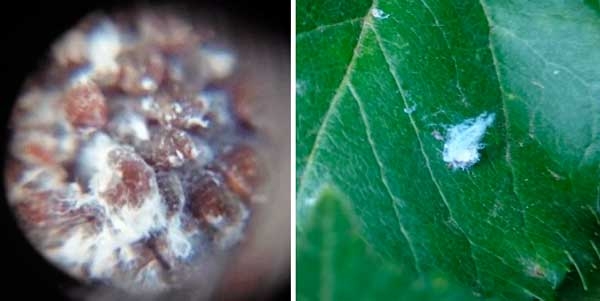Failure to control aerial infestations of woolly aphid can result in underground infestations on susceptible rootstocks.
Control root colonies
Soil drench
In order to control root colonies, an insecticide registered for use as a soil drench should be applied.
A soil drench can be used on trees up to seven years old. Timing is critical, and the application needs to be made between green tip and petal fall.
In order to obtain efficient woolly apple aphid control it is important that the active roots can take up sufficient quantity of product. This is achieved by ensuring soils are moist prior to application, preventing the product from flowing away from the treated area, and ensuring the application zone is weed free.
Resistant rootstocks
Resistant rootstocks provide the best defence against underground infestations.
The Merton-Malling (MM) series is resistant to woolly aphid. MM102 provides an option for orchardists with high-density blocks where woolly aphid is likely to become a problem on more susceptible varieties.
Natural enemies
Woolly aphid has several natural enemies such as earwigs, lacewings and ladybirds but is more frequently parasitised by Aphelinus mali, a small parasitic wasp.
A. mali plays a major part in suppressing woolly aphid populations, but their effectiveness depends on selectivity of pesticides used in production as beneficial organisms are generally more susceptible to chemicals than the target pest species.
Furthermore, when compared to woolly aphid, this predator requires higher temperatures to initiate its development, therefore aphid colonies cause damage before the wasp becomes active.
Insecticide field trials
Fruit Grower Victoria conducted field trials in 2015–16 for the 'Future Orchards Project', with different applications of insecticides for the control of Woolly Aphid.
In these trials we compared foliar applications, root drenching and a combined application of both treatments.
Foliar application
Foliar application of insecticides for the control of Woolly Aphid is commonly used.
There are number of active ingredients registered for this purpose. Some are used while the trees are in leaf—while the colonies are present on the tree; and some of them—those that are less selective with high toxic and residual properties—are used during dormancy.
(continued next month)
See this article in Tree Fruit Feb 2017




















